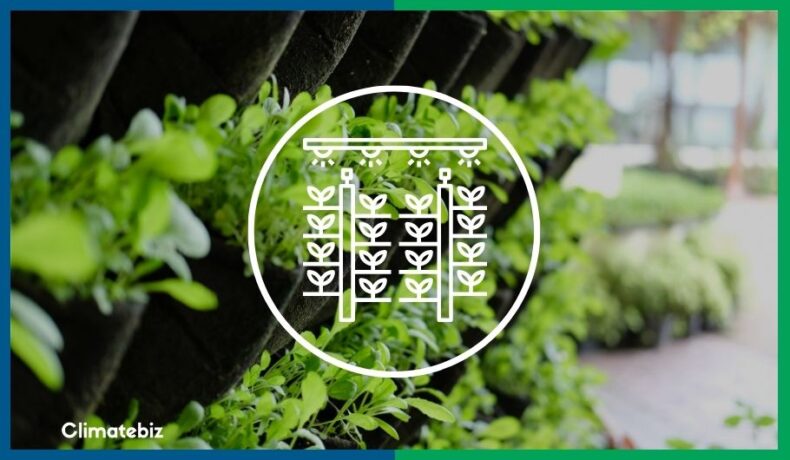Looking to grow vegetables but have limited space? Fear not, for you are about to discover the top vegetables for vertical gardening!
Most of you have seen the news headlines, so it comes as no surprise to us that climate change has become a determining factor in the way we produce food.
As global temperatures rise and populations grow exponentially, environments become harsher, and there is limited space to grow.
Thankfully there is an effective way to become a little more self-sufficient. It includes a vertical garden and an array of vegetables!
Join us as we delve into the nitty-gritty and discuss the best vegetables for vertical gardening.
Table of Contents
15 Best Vegetables For Vertical Gardening
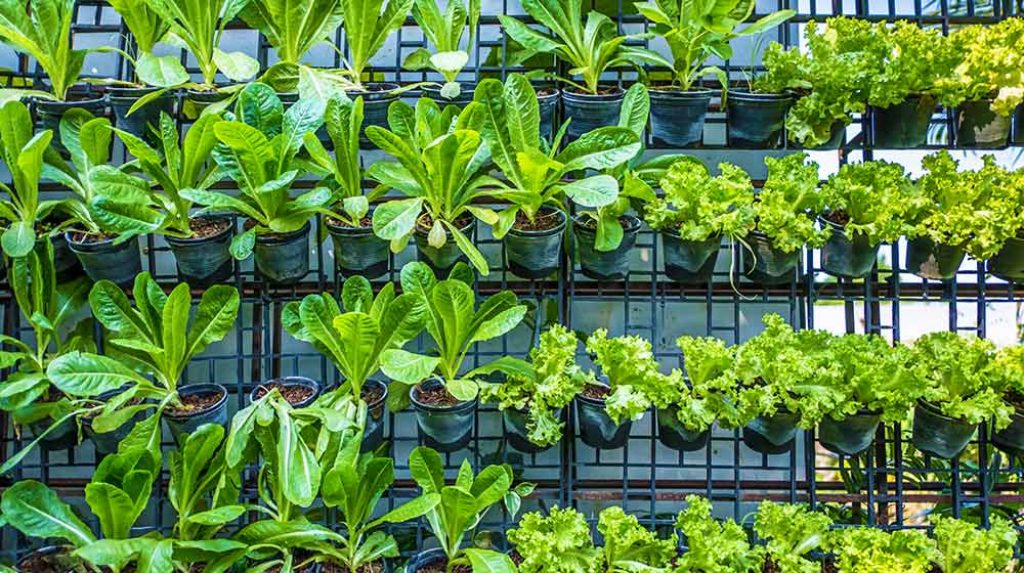
Source: Garden Season
Vertical gardening systems certainly have drawn our attention lately.
These systems have taken self-sufficiency and sustainability to a new level.
Gone are the days of using massive pieces of land for agricultural practices — the future is here!
Let’s look at what vegetables are at the top of the list for vertical gardening.
1. Green Beans
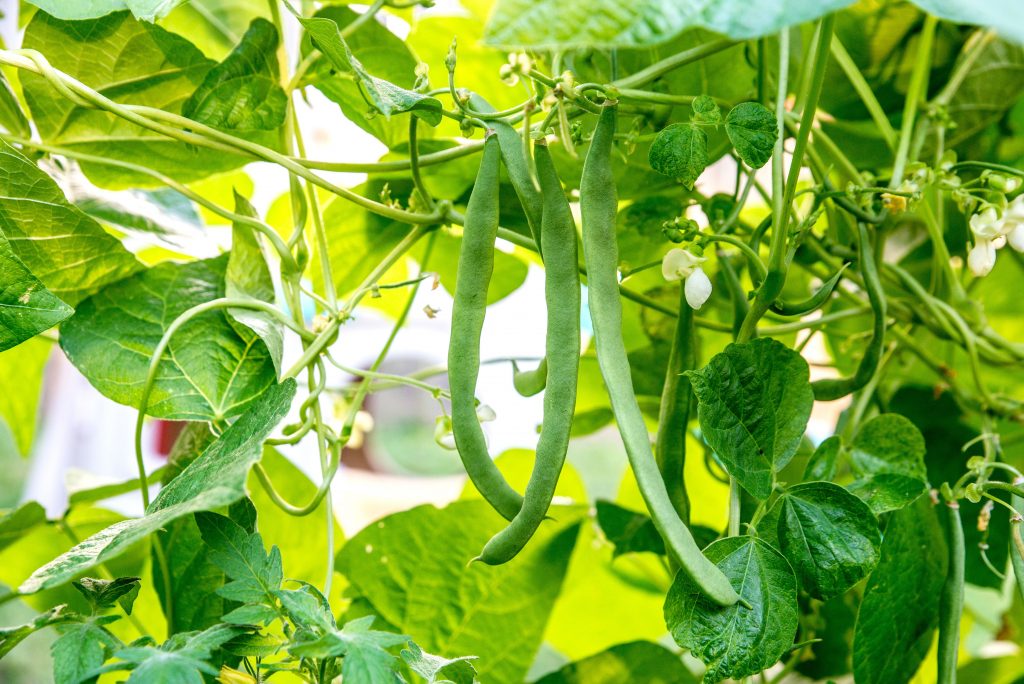
Source: The Spruce
Green beans are a widely loved staple vegetable in many households. Some prefer them raw, others like them cooked.
Either way, this nutritious vegetable is an excellent source of vitamins, protein and contributions to healthy hair, muscles, and weight control.
Tips For Growing
Bush beans or pole beans are a great option for vertical gardening.
Green beans love warmer weather, so a great tip is to plant your beans after the last wave of frost has cleared up for the winter.
Common Problems
After planting your green beans, be on the lookout for any unwanted critters that may pop up. Commonly experienced pests include slugs and beetles.
Beans are also quite vulnerable to fungal diseases in very wet conditions. Before getting your fingers dirty when the weather is wet, something to keep in mind!
Top Mediums For Growth
These nutritious veggies grow best in clay or silt loams. Composting is great and proper drainage is recommended.
Preferred Light
Around 6 hours of sunlight is adequate or 6 hours under a suitable grow light indoors.
Best pH Levels
Beans prefer marginally acidic soils and neutral soils between pH 6 and 7.
Nutritional Value
Green beans are a great source of vitamin C, vitamin A, folate (vitamin B), and minerals such as manganese.
2. Garden Peas
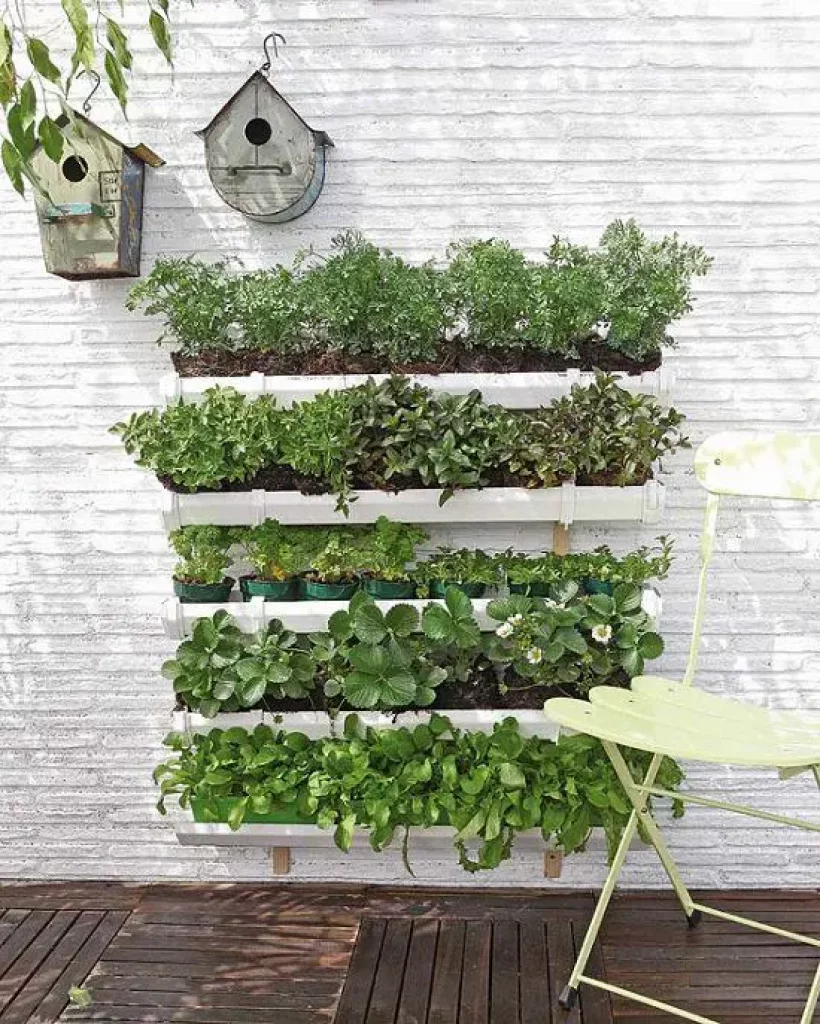
Source: Balcony Garden Web
Green peas/garden peas are incredibly nutritious!
Peas contain vitamins, high protein content, and burst with polyphenol antioxidants. The health benefits of peas include sugar control, aiding digestion, and overall better health.
Tips For Growing
Peas are great to grow vertically on a trellis. Choosing a trellis structure will allow for better airflow and make it easier for you to harvest.
With the pods hanging right in front of you, this tip is sure to improve your gardening experience!
Common Problems
Peas tend to grab and grow!
In other words, they will grow onto anything nearby. This can sometimes lead to problems such as intertwining with other plants.
Training the growth through tucking and guiding is a way to combat this — just be careful not to make them too tight; otherwise, you may end up accidentally strangling or breaking them.
Top Mediums For Growth
Peas grow well in loamy soils, which can drain well. A potting mix is always a great way to go!
Preferred Growing Light
Peas thrive in partial sun exposure and do well in bright light (as long as it isn’t harsh!).
Indoor fluorescent lights can be used, provided they give the peas around 8 hours of steady light per day.
Best pH Levels
Between 6 – 7.5.
Nutritional Value
- High protein
- Source of fiber
- Vitamins A, K,C, Thiamine, Folate
- Manganese, Iron, Phosphorus
3. Tomatoes (Vining)

Source: Real Simple
Ok, you caught us. Tomatoes are technically a fruit.
These family favorites are munched directly off the vine or finely chopped into a salad!
So, you can’t blame us for adding them to the list, can you?
Tips For Growing
Tomatoes grow best in warmer climates that see longer growing seasons, so grow them in a suitable environment!
These bright and succulent plants are also quite particular regarding spacing requirements. Read up on your chosen type carefully, as adequate spacing is essential for good growth.
Common Problems
Tomatoes have a habit of crowding.
When greenery crowds the vertically growing tomatoes, the plant will not receive sufficient light. Lack of light will result in a lack of growth. You can overcome this issue with regular pruning.
Top Mediums For Growth
Recommended mediums for tomato growth are soils that drain well and a significant organic component. High-quality composts and potting mixes are an absolute win!
Preferred Growing Light
Vining tomatoes need total sun exposure when planted outdoors. Indoors, tomatoes will either need a fully lit and bright room or a high output fluorescent light.
Best pH Levels
The ideal soil pH is between 5.5 and 7.
Nutritional Value
Very high in vitamin C!
4. Cucumbers
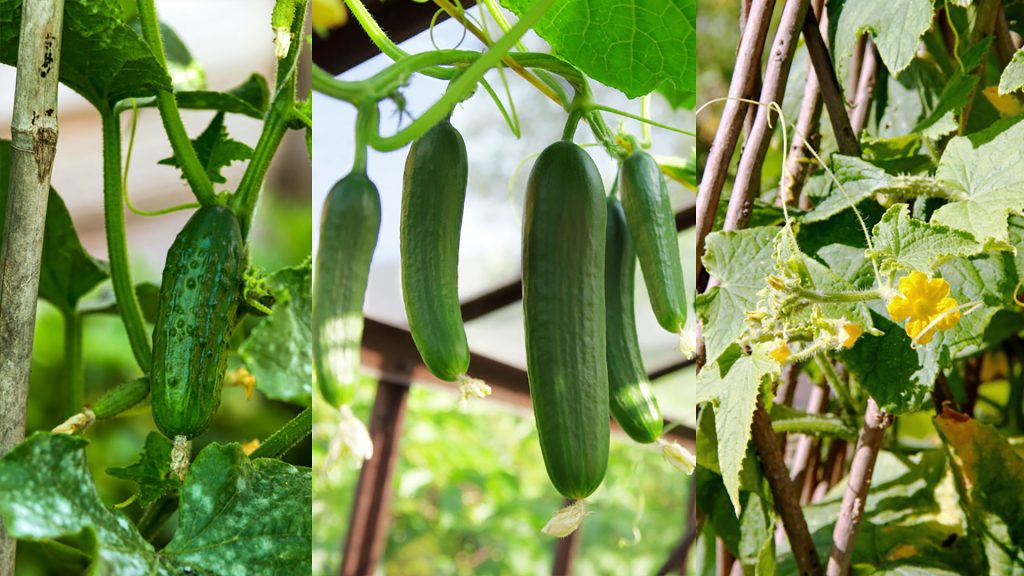
Source: Homes & Gardens
Both crunchy and fresh; cucumbers are easy to grow and love their water!
Tips For Growing
Plentiful watering is a crucial tip for a great turnout!
Cucumbers need deep watering. However, it’s essential not to over-water them — you’d undoubtedly prefer to avoid an outbreak of fungal disease!
Common Problems
Pests are often picked up on cucumbers and usually include common garden pests such as aphids. Regular inspection of your plants is an effective way to reduce this problem.
Top Mediums For Growth
Soils that drain well contain high organic matter levels and have a loose structure.
Preferred Growing Light
Cucumbers need warmth and lots of sun.
Best pH Levels
A neutral pH range.
Nutritional Value
Cucumbers are an excellent choice for hydration and controlling weight.
Additional nutrition includes protein, fiber, vitamin C and K, and magnesium and potassium.
5. Spinach
Nutrient-rich and lovely to grow! Spinach is an excellent choice of vegetable for vertical gardening.
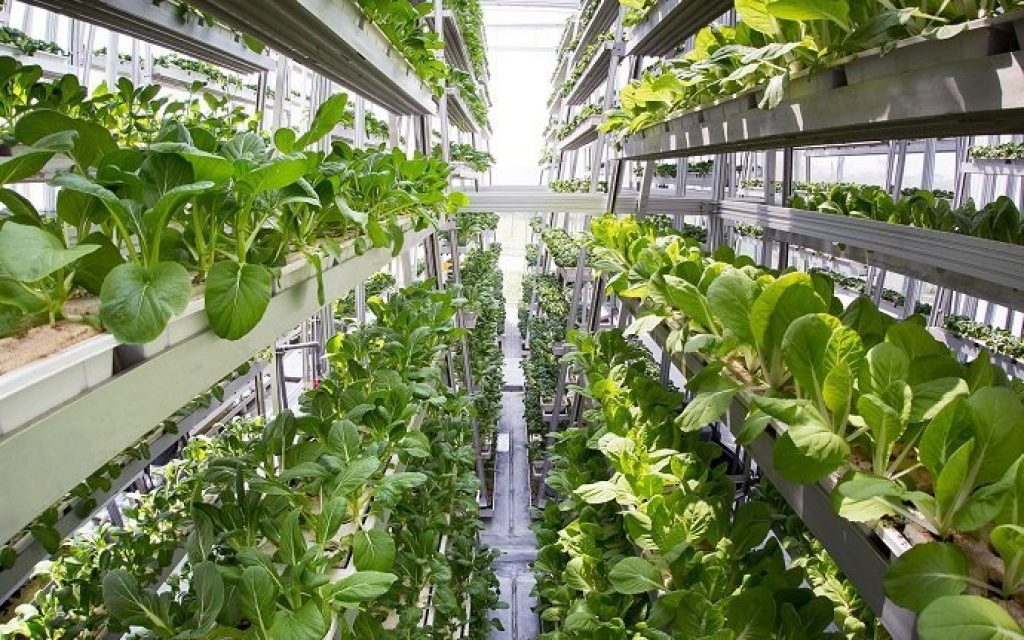
Source: Permaculture Research Institute
Tips For Growing
Great news — multiple harvesting is possible with spinach!
When growing your leafy green, start pulling the leaves out at a relatively useable stage. This allows the plant to grow new leaves and provides more spinach in one season.
Common Problems
Leaf beetles are insects seen to chew at this leafy vegetable, leaving tiny circular holes en route.
We advise that you regularly inspect your spinach to identify any pests as soon as possible.
Top Mediums For Growth
Rich, well-drained soils.
Preferred Growing Light
Spinach grows best with 6-8 hours of sunlight a day. You can also choose indoor grow lights which will need to provide around 10-12 hours of sunshine a day.
Best pH Levels
Best results occur at soil pH between 6.5 to 8.
Nutritional Value
- High in vitamin K
- Vitamin A and C
- Iron
- Calcium
6. Leek
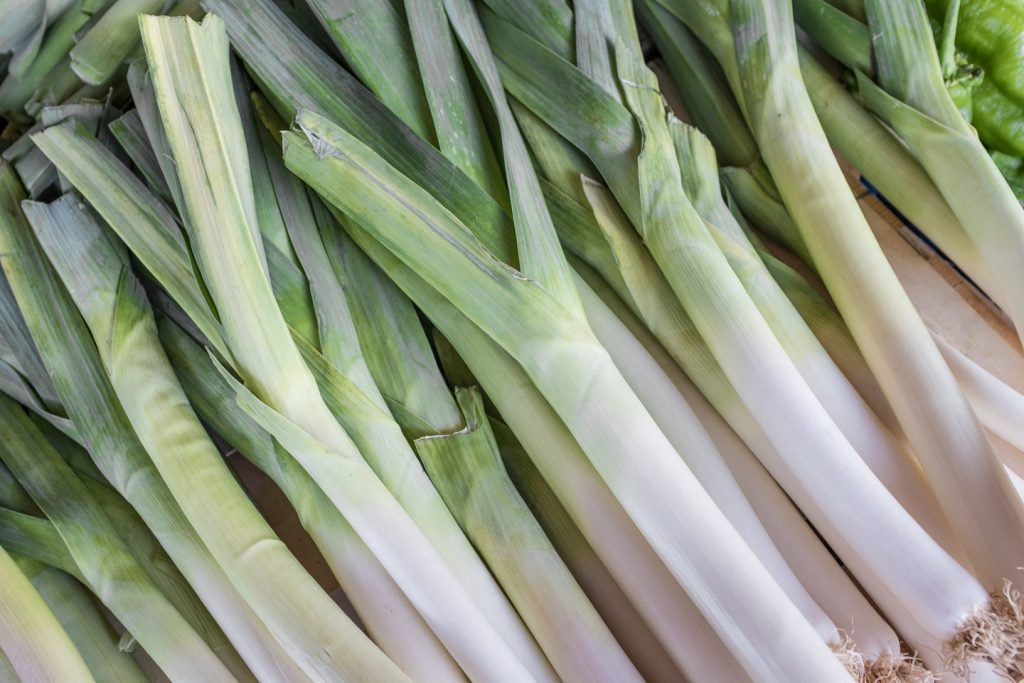
Leeks can be successfully grown in a vertical garden set-up.
When grown in container systems, these vegetables are winners and make a great addition to your onion family!
Tips For Growing
Leeks grow well in cooler weather. If you allow them to experience a bit of frost, they may produce a better flavor.
Common Problems
The leek moth is a common pest that loves to take hold of these culinary delights. Keep an eye on your vertical garden regularly for early detection.
Top Mediums For Growth
A lighter, richer soil that drains well.
Preferred Growing Light
Leeks thrive off bright and sunny environments. If you grow them indoors, you can use grow lights and provide a lit environment for around 10 hours a day.
Best pH Levels
Between pH 6 and 7.
Nutritional Value
Leeks are highly nutritious and include:
- Magnesium
- Vitamin A, C and K
- Small presence of fiber, iron and vitamin B
7. Cabbage
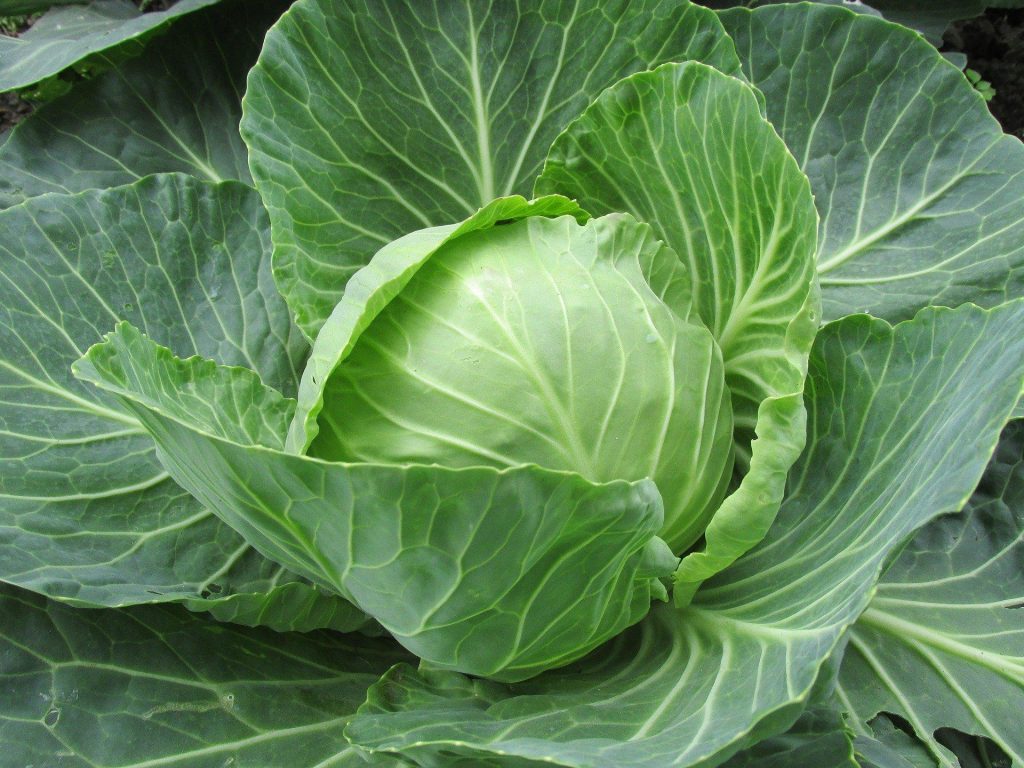
Cabbage, such as Chinese cabbage, is generally well-suited to cool temperatures.
Tips For Growing
When exposed to more light, cabbage leaves seem to produce a more significant mass.
A helpful tip here would be to use a system layout that ensures cabbage leaves at the bottom receive a decent amount of light as those on top.
Common Problems
Cabbage is relatively temperate sensitive. A commonly experienced problem is the splitting of cabbage instead of head formation. Planting at the right time is critical for successful growth.
Top Mediums For Growth
Moist, nitrogen-rich compost, and well-draining soil.
Preferred Growing Light
Although shade tolerant, cabbage prefers around 6-8 hours of full sun.
Cabbage can be grown indoors with high-intensity grow lights that equal natural lighting requirements.
Best pH Levels
The ideal pH range for cabbage growth is between 6 and 7.
Nutritional Value
Cabbage is packed with an array of vitamins such as B6, C, K. This vegetable also contains minerals, including magnesium and potassium.
Finally, it’s essential to mention that fiber is abundant in this leafy plant.
8. Red Chilli

Super achievable in small spaces- chilies are fantastic container vertical vegetables!
Tips For Growing
This fiery veggie is quite particular when it comes to successful growth.
A tip to remember is that chilies love warmth and shelter at the seed stage. At the same time, they need a decent amount of light and like to dry out a bit in between.
Common Problems
Inadequate and incorrect watering practices are the most common problems when growing chilies. It’s essential to consider your plant’s specialized needs to overcome this.
Top Mediums For Growth
Chilies must be grown in a medium that allows the roots to be exposed to air. They require regular cycles of wet and dry conditions.
You may use a variety of composts.
Preferred Growing Light
Ideally, 12-16 hours of light followed by 8-12 hours of pure darkness.
Best pH Levels
A pH between 6 and 7.
This is very important if you aim towards big and healthy chili plants!
Nutritional Value
Chilies are powerful antioxidant producers — a great benefit for your immune systems! Moreover, they contain vitamins A, K1, and B6 and minerals.
9. Carrots
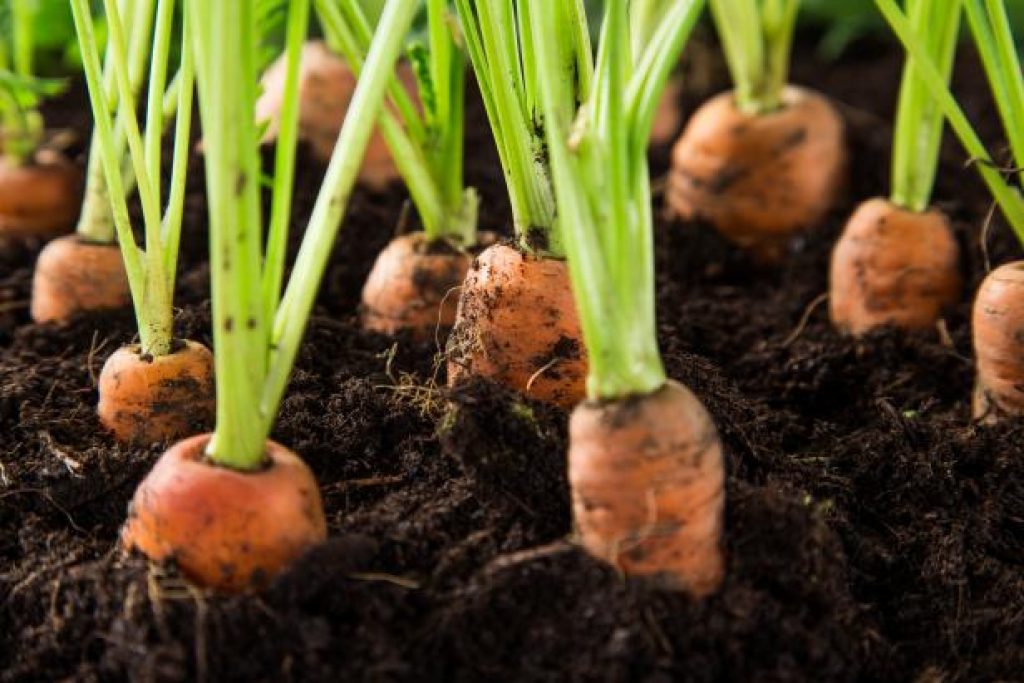
Source: HGTV
Did you know that carrots are vegetables for vertical gardening that can be grown on your balcony? Yes, you read correctly!
Tips For Growing
To prevent yourself from disturbing carrots still in their baby growth phase, cut fully-grown carrots from their base instead of uprooting them.
Common Problems
When you water carrots at a mature level, they tend to crack.
You can address this by reducing your watering before they reach full maturity.
Top Mediums For Growth
Soils that are aerated and quite porous due to this vegetable being rooted. Sandy loam soil does well!
Preferred Growing Light
The best light for carrot growth is a minimum of 8 hours a day. LED grow lights make for suitable alternatives when carrots are grown indoors.
Best pH Levels
Neutral up to marginally acidic, between 6 to 7.
Nutritional Value
This vegetable for vertical gardening is rich in fiber, potassium, vitamin K and additional antioxidants.
10. Winter Melons
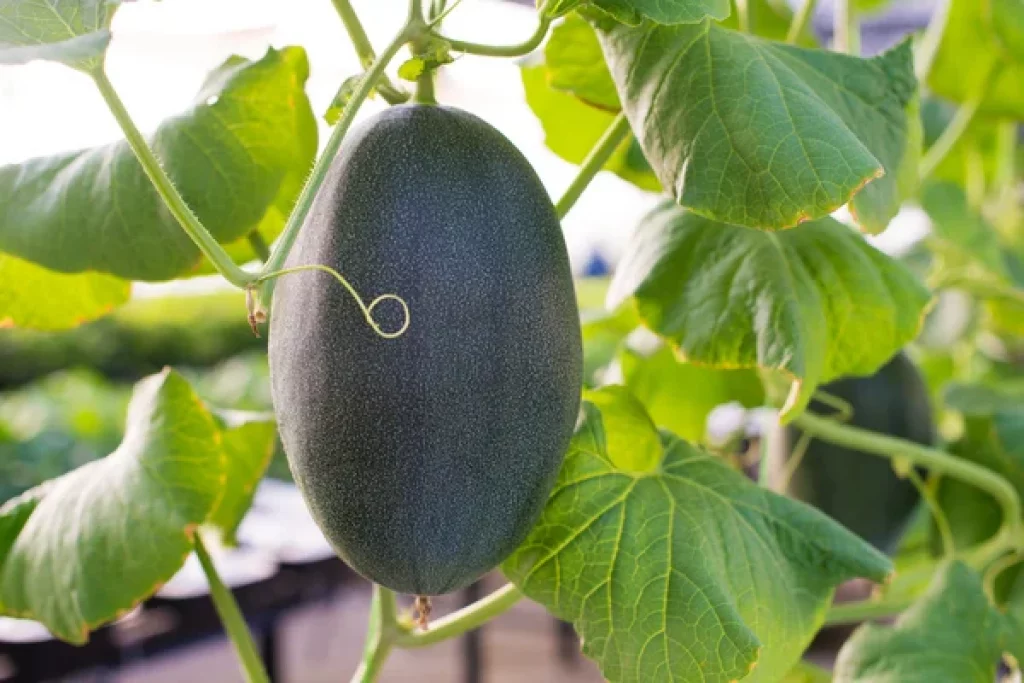
Melons are possible one of the most underrated vegetables for vertical gardening!
Besides the fact that they are a vegetable — not a fruit — melons can be trained to vine.
Tips For Growing
Consistently trimming your vining melon will ensure control and encourage further vining from the plant.
Common Problems
Melons are pretty darn heavy and can bring down a vertical structure in an instant. You can prevent this from happening by providing them with a strong support structure.
Top Mediums For Growth
Moist, loose soils, comprise organic matter and drain well.
Preferred Growing Light
Melons prefer growing in full sunlight.
If grown indoors, a bright and sunny spot is ideal. You can also use specialized lighting if sunlight availability is at a minimum
Best pH Levels
6-6.8.
Nutritional Value
High levels of vitamin B2 and C and an array of minerals, including zinc.
11. Squash
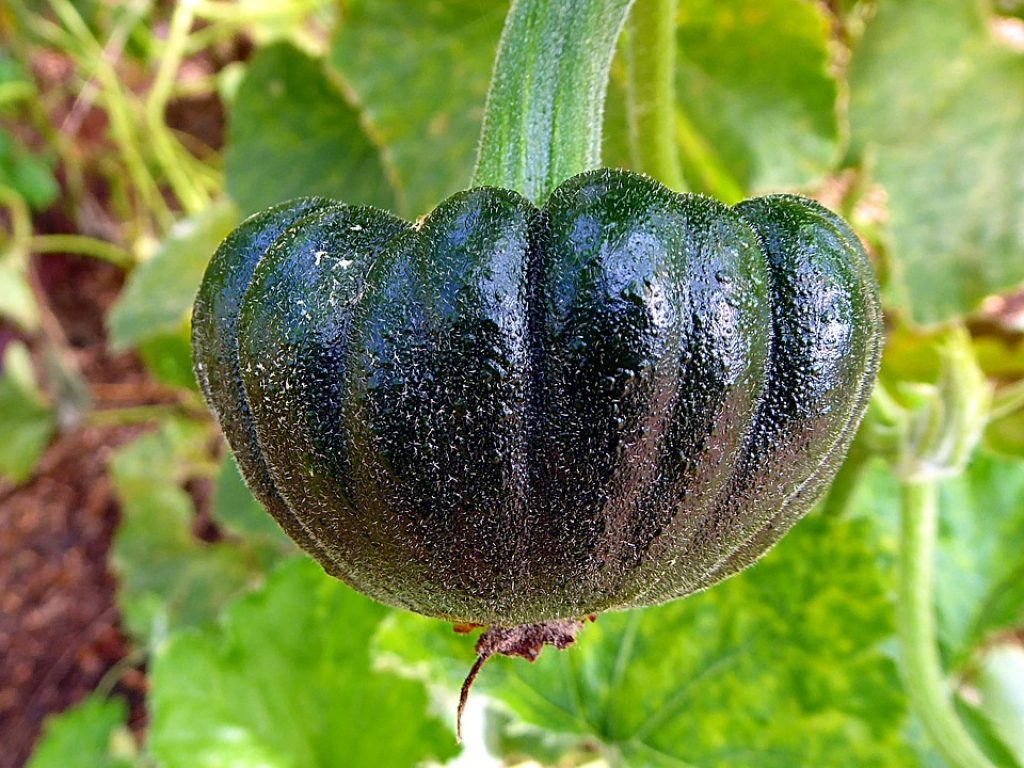
Squash is a pretty dominating vegetable for vertical gardening!
This greenery loves to spread its stems out and spill over into every available space around it.
Tips For Growing
To help steer your squash upwards, you can weave the growing shoots within your vertical gardening structure.
Common Problems
As in the case of melons, squash can become rather heavy. You can aid the support of these veggies by placing nets or cloths over the vines.
Top Mediums For Growth
Moist soils and nutrient-rich compost.
Preferred Growing Light
Squash needs more than 7 hours of direct sunlight a day for optimal growth. This can be substituted indoors with an equating bright grow light.
Best pH Levels
Ideally, a pH of 6-6.8.
Nutritional Value
Squash is beneficial in aiding digestion due to its high fiber content. This veggie is also high in vitamin C.
12. Peppers
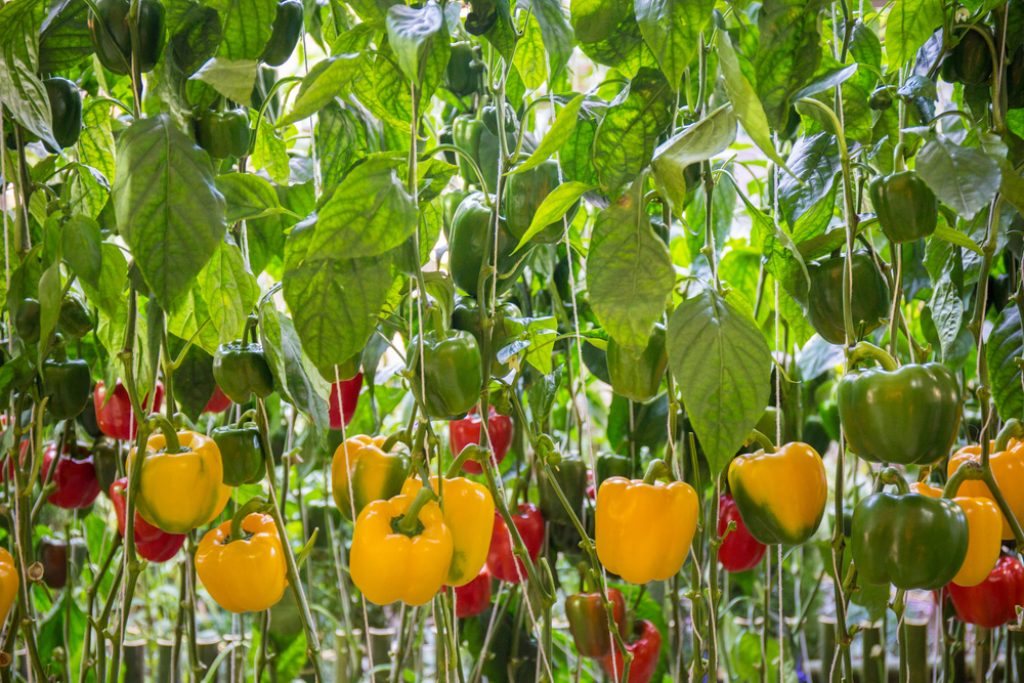
Source: Rise Hydroponics
Heat is the keyword with this vegetable!
Tips For Growing
Peppers are warm-weather lovers! So, if you live in an area that experiences shorter summers — get planting with starter plants for a timely pepper harvest.
Common Problems
These towering vegetables for vertical gardening tend to block out light for those lower down. The best way to combat this would be to plant your smaller ones on top.
Top Mediums For Growth
A light, moist, nutrient-rich soil. Potting mixes are highly recommended.
Preferred Growing Light
Summer sunshine is ideal for pepper growth, but you can explore adequate indoor LED lighting alternatives.
Best pH Levels
The best pH levels are between 6.5 and 7.
Nutritional Value
Often not realized, peppers contain a very high level of vitamin C!
13. Zucchini

A trending alternative to conventional pasta — those enjoyable zucchini noodles can come straight from your home!
Tips For Growing
Zucchini plants become quite heavily loaded, so ensure you have a sturdy supporting structure in place.
Common Problems
Powdery mildew is a disease often occurring among gardens. To avoid this, try not to overwater your plants.
Top Mediums For Growth
Zucchini grows best in soils rich in loam and well-drained.
Preferred Growing Light
This vegetable grows best in full sunlight. You can use adequate and equal indoor lighting to replace a full day’s exposure.
Best pH Levels
Around 6.5
Nutritional Value
- Vitamin A, B6, C and K
- Potassium and magnesium
- Fiber
14. Broccoli
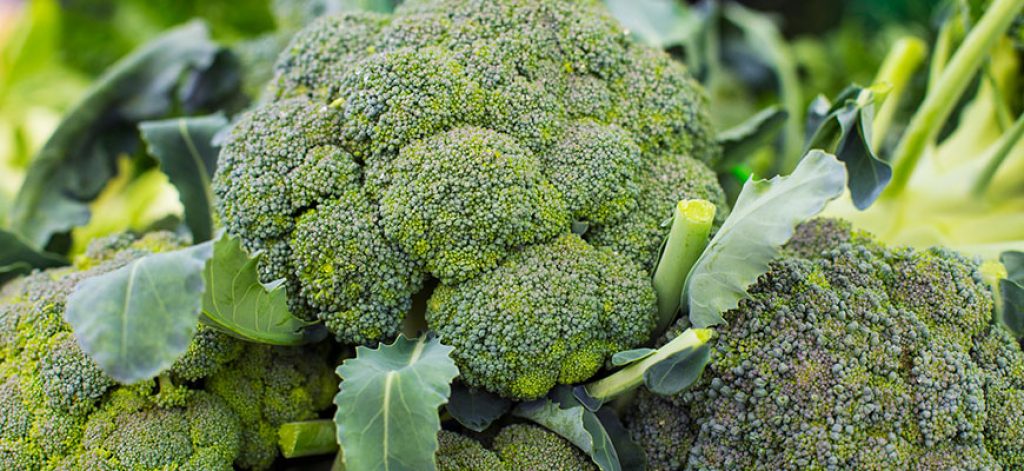
Ah, yes. The beautiful broccoli — one of the healthiest vegetables for vertical gardening!
Tips For Growing
Although this is a cool-season vegetable, avoid exposing your crop to cold for too long.
Common Problems
If broccoli is exposed to heat too quickly, the heads become loose. Ensure that you plant them at the correct time to overcome this speed bump in the road.
Top Mediums For Growth
Top mediums include a compost mix within soils.
Preferred Growing Light
Broccoli plants thrive in full sun.
Regular indoor lights are not a sun substitute for these vegetables. However, you can purchase an adequate grow light to replace the required hours of sunlight.
Best pH Levels
Between 6-6.5.
Nutritional Value
Broccoli is high in fiber vitamins (C and K) and provides a great source of minerals such as iron.
15. Kale
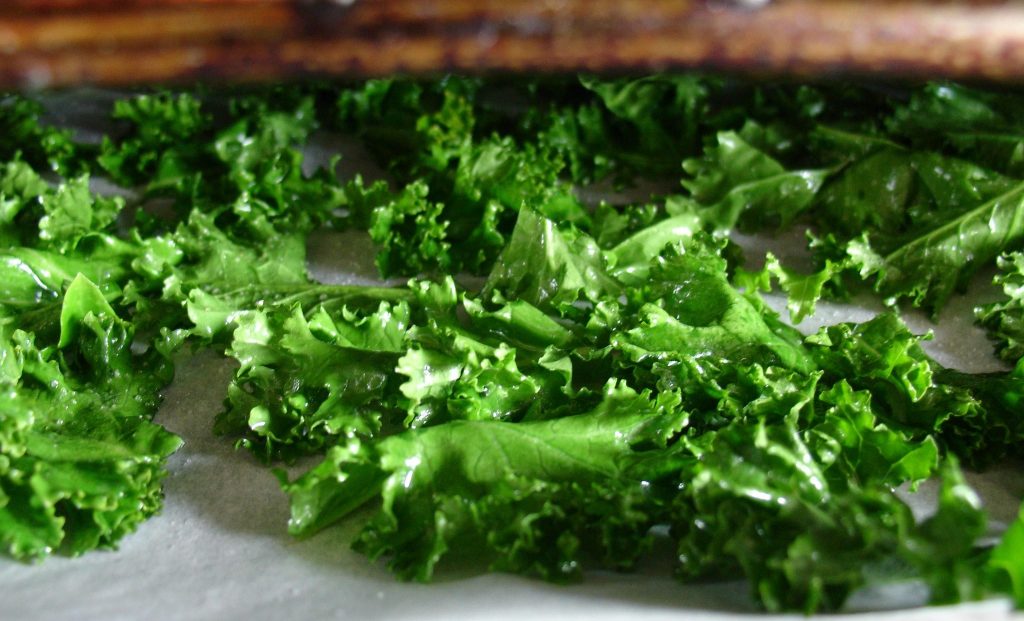
Kale — the green juju that gets us going! This leafy crop is a vertical garden favorite, simply bursting with nutrition.
Tips For Growing
Kale is a great “cut and come again” vegetable! If you harvest the leaves carefully, they will grow back within the same harvest.
More green goodness!
Common Problems
Leafy pests such as aphids are a problem when it comes to kale. Thankfully, a vertical garden reduces them quite significantly.
That being said, you should keep a sharp eye on your crop for any uninvited crawling guests.
Top Mediums For Growth
A rich soil that drains well is ideal for growth.
Preferred Growing Light
Kale needs around 5 hours of direct sunlight. Alternatively, you can use a grow light to provide the adequate light required for growth.
Best pH Levels
6-7.5
Nutritional Value
Kale is classified as being a superfood! In other words, this green goodness contains high levels of vitamins (such as A, B6, C, and K) and minerals (including calcium, manganese, potassium, and copper).
Is Growing Vegetables in a Vertical Gardening System Worth It?
Vegetables are relatively easy to grow – given that you choose ones suitable to the season and your environment (including those where you have control of the light).
Incorporating them into a vertical garden is a great way to save space, turn your greenery into something you can consume, and a great start to becoming more self-sufficient.
Getting good greens in is vital for our health and well-being. Vertical vegetable gardens will undoubtedly supply an abundance of this!
So if saving space and becoming self-sufficient is a goal of yours, then growing vegetables in a vertical gardening system is worth it.
Do Vegetables Grown Vertically Taste Different?
The taste of vegetables depends significantly on the amount of light they receive, the water they are given, and the nutrients flowing into the growing medium.
If your vertical garden uses different water and nutrients than the vegetables are grown commercially, you may notice a slight difference.
That being said, the way you combine and prepare your vegetables will also determine the taste. For example, if you’re keen on spices, you will experience a unique taste!
So no need to worry – your vegetables will still be mouthwatering, even if they grow upwards.
Which Nutrients Should I Use For My Vegetables?
Various vegetables prefer various nutrients. In some cases, additional nitrogen is preferred and boosts growth, but in other cases, it is not.
To determine what would be best for your vegetable and set-up, you need to do proper research!
Final Thoughts
If there is one message that resonates loud and clear, it would be that there certainly is a variety of vegetables for vertical gardening!
The options reach far and wide, from the fiery chili to the mellow melon.
The most crucial factor is the suitability of your environment, the set-up you have, and the requirements you will need to meet.
Do your research, ask for advice from professionals, and you can be assured that there is a veggie out there for you!

